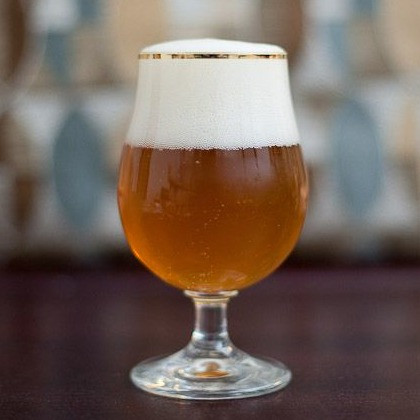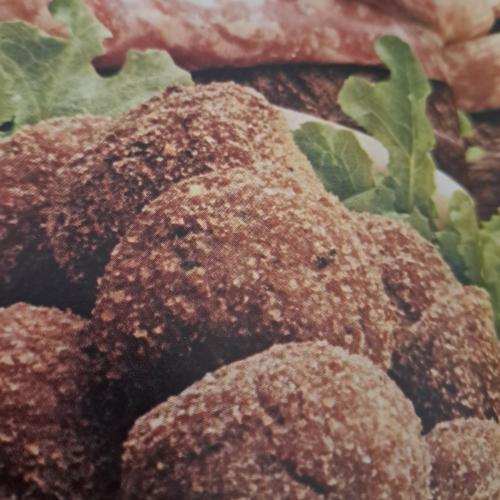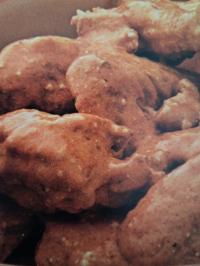Copy Link
Add to Bookmark
Report
HOMEBREW Digest #0825

This file received at Mthvax.CS.Miami.EDU 92/02/17 03:12:42
HOMEBREW Digest #825 Mon 17 February 1992
FORUM ON BEER, HOMEBREWING, AND RELATED ISSUES
Rob Gardner, Digest Coordinator
Contents:
[bradley@adelphi.edu: Re: Hilbert and other amusing anecdotes...] (Anthony Rossini)
Cracked carboy (Dominic Ryan)
Reusing yeast. (UNDERWOOD)
Glass cracking (wbt)
Glass and temp (dbreiden)
Infections, Red Hook yeast (Norm Pyle)
freezing hops and old Wyeast (John Freeman)
Help!! I'm trapped in a non-brewery! (Eric Mintz)
Glass and temp, Gum arabic (Carl West)
hop storage (donald oconnor)
Re: Wyeast packaging (Richard Stueven)
Yeast culturing flames (Darren Evans-Young)
Sam Adams news (gkushmer)
My Honey Basil Ale (Bryan Gros)
Re: Glass temp (Robert Schultz)
send entry (John Buchanan)
Holiday Ale, Yeast Culture Media (hays)
Nutritional Value of Homebrew (Katy T. Kislitzin)
Forced CO2 vs natural (NCDSTEST)
Roller Mill ("71011,3653 @compuserve.com")
Recipe for brewing Full Sale Ale (Gene Schultz)
First-Timer (ZLPAJGN)
Red Star, BEER BREAD (Jack Schmidling)
RESULTS: Axbridge beer kit (trwagner)
Calgary, Alberta pub... (GARY MASON - I/V/V PCU - 603-884[DTN264]1503 15-Feb-1992 1209)
Brewing Bibles (x881152)
Filtering wort (Conn Copas)
Burst WYeast packets and mailorder (John A. Palkovic)
re:glass breaking & spent grains (Kevin Yager)
Send submissions to homebrew@hpfcmi.fc.hp.com
Send requests to homebrew-request@hpfcmi.fc.hp.com
[Please do not send me requests for back issues!]
Archives are available from netlib@mthvax.cs.miami.edu
----------------------------------------------------------------------
Date: Fri, 14 Feb 92 07:10:03 EST
From: rossini%biosun2@harvard.harvard.edu (Anthony Rossini)
Subject: [bradley@adelphi.edu: Re: Hilbert and other amusing anecdotes...]
> Date: Wed, 12 Feb 92 15:22:59 -0500
> From: bradley@adelphi.edu (Robert Bradley)
>
> >From Walpole & Meyers, _Prob_&_Stats_for_Eng_&_Sci_:
>
> "The T distribution was first published in 1908 in a paper by W. S.
> Gosset. At the time Gosset was working for an Irish brewery that
> disallowed publication of research .... he published his work secretly
> under the name 'Student'."
>
> Once again, the art brewing inspires scientific advancement! Does anybody
> know if the "Irish brewery" was Guinness?
The Irish brewery was indeed Guinness. Gosset was actually brewmaster, and
the basis for the Student's T was so that he could do small sample
scientific comparisions whose data analysis was to be used to standardize
the brewing process (it's been a while since I perused the historical side
of his paper).
Another interesting note is that R. Fisher, a very famous statistician, knew
and corresponded with Gosset (and Fisher later improved on Gosset's original
formula). One letter he wrote asked Gosset about hints and techniques to
make his (Fisher's) homebrew better. The gist of Gosset's reply (boy I wish
I had the reference, the actual quote was a beaut!) was to stick with the
statistics (which would directly help Gosset and indirectly help Guinness)
and let him (Gosset) handle the beer (i.e. the advice was basically :"Drink
Guinness").
You'd have to read the rest of the letters to realize that Gosset was a
wonderful character - just about everyone liked him (among his friends were
some pretty strong enemies) and he basically felt that Fisher would be
wasting his time homebrewing, when he (Fisher) could be assured that Gosset
was doing his best to insure that every batch of Guinness would be great...
That, and the quote from Hilbert about that if it can't be done with beer
mugs, tables, and bar stools it just isn't mathematics, are probably my
favorite math-stat/beer stories...
-tony
- --
Anthony Rossini - rossini@biostat.harvard.edu
Department of Biostatistics, Harvard School of Public Health
677 Huntington Ave, Boston MA 02115 617-432-1056
------------------------------
Date: Fri, 14 Feb 92 07:51:20 EST
From: silver@mhuxd.att.com (John W Jensen)
Please remove me from the Homebrew list.
Thanks, john
------------------------------
Date: Fri, 14 Feb 92 08:14:23 EST
From: ryan@phmms0.SMITHKLINE.COM (Dominic Ryan)
Subject: Cracked carboy
Glass can be cracked from thermal shock in either direction. What
counts is the rate of temperature change and the thermal expansion
factor for the glass. The lower the expansion factor the better the
glass is able to withstand thermal shock. This is why Pyrex is good
and quartz even better, they have very low coefficients.
I suspect that the reason your carboy did not survive hot->cold but did
cold->hot is that you are not able to heat as fast as you are able to
cool. Heat transfer to a snow bank will be much faster than heat
transfer to the bottom of the carboy from your heat source. If you
were to get a big enough flame localized on one part of the carboy it
would crack. There is an old technique for cutting the top of a wine
bottle. This consists of filling the bottle to the desired level with
oil and plunging a hot poker from the fire into it. The glass will be
cracked very neatly around the surface of the liquid. I have a book
from the late 1800s that describes this as an 'old' trick. I have not
tried it, but modern glass may have more trouble with this since it is
much more uniform.
Finally, the older the glass the more suceptible it is to thermal
shock. This is because glass is actually a liquid and flows however
imperceptably slowly. The effect of this is not to actually change the
shape of the glass, but to build up strain in the glass. This strain
makes it much more liable to crack on thermal shock. Repeatedly
heating glass to only one or two hundred degrees will also accelerate
this. Modern glass is gradually cooled after casting/blowing/forming
in order to prevent this. Glass may also be annealed to remove strain
by slowly heating to just below the softening point of the glass in
question and then cooling even more slowly. For Pyrex glassware this
will mean heating to about 800 oC over a few hours and holding there
for a few more and cooling over about 12 hours. For glass with a
greater thermal expansion coefficient a slower heating and cooling rate
is needed. This operation is carried out in an annealing oven. The
effects of strain can be visualized with a polarizing screen, strain in
glass will rotate plane polarized light non-uniformly. Annealing glass
is also important if it to be subjected to pressure or vacuum. If
under vaccum the pressure differential is about 15psi, beer bottles
hold around 5-10 psi pressure usually. They are also built to
withstand more than that.
Various people have commented in the past on the use of the oven or
dishwasher to sterilize bottles. These considerations would argue in
favor of using the dishwasher but not the oven. The temperature increase
in the dishwasher is minor, and not likely enough to affect the glass
much. However, a temperature of 400F (~200C) is enough to expand the
glass and increase strain, but *not* enough anneal it, which would require
about 1400F (800C) for while. I don't actually know what the composition
of beer bottle glass is, anyone else know? I no longer work with glass
since I am no longer a 'bench' chemist, but I witnessed the unfortunate
effects on improperly annealed apparatus on several experiments...
M. Dominic Ryan (215)-270-6529 SmithKline Beecham Pharmaceuticals
------------------------------
Date: Fri, 14 Feb 92 05:32:53 PST
From: UNDERWOOD@INTEL7.intel.com
Subject: Reusing yeast.
Hello HB'ers.
I am about to partake in my first batch made with
liquid yeast (oooh aaah). My question is, and I
believe it's been asked before with very little
response....
What do you do to reuse this stuff in another batch.
Papazian's method was kinda vague to me and I don't
quite remember what Miller said but I believe it wasn't
much better.
Can some kind soul give me a step by step? I want to
make a batch this weekend and another say in a month or
two. Mail to me directly and I'll post if there's
interest.
Thanks a bunch.
Cu
Underwood@Intel7.Intel.Com
------------------------------
Date: Fri, 14 Feb 92 10:16:56 EST
From: wbt@cbemf.att.com
Subject: Glass cracking
From: dbreiden@mentor.cc.purdue.edu
Subject: Glass and temp
> Seems I can boil boiling water in a room temp glass bottle with no problem.
> But last year when I put my carboy in a snow bank (yeah, it was warm, but
> not HOT HOT DAMN HOT), I returned to the earth what the earth had given
> me -- and kissed a carboy good bye.
>
> So my personal experience seems to indicate that glass can handle cold->hot
> better than hot->cold.
I'll bow to a ceramist if there's one reading. My impression, though,
would be that it doesn't matter if you're going hot->cold or vice versa.
What is important is the temperature difference between the hot and cold
*and* the absolute lowest temperature.
The resistance of glass to thermal shock should decrease with temperature;
the colder it is, the more prone it will be to breaking. So a 100-degree
delta between your hot and cold masses would be more likely to cause
breaking if your cold mass is at 0 Fahrenheit than if it's at 90
Fahrenheit.
- - - - - - - - - - - - - - - - - - - - - - - - - - - - - - - - - - - -
Bill Thacker AT&T Network Systems - Columbus cbemf!wbt
Quality Engineer Network Wireless Systems wbt@cbemf.att.com
------------------------------
Date: Fri, 14 Feb 92 08:22:31 MST
From: pyle@intellistor.com (Norm Pyle)
Subject: Infections, Red Hook yeast
To Gordon Baldwin:
A friend of mine (who brews very high-quality beer) had an infection problem
which was traced (as well as possible) to the dishwasher. Just because the
dishwasher has worked for years doesn't mean it will work always. I assume
food particles get trapped periodically in strange places and bacteria sets
up camp. I use bleach in my dishwasher (no detergent) and haven't had a
problem (although I'm not claiming I won't _ever_ have one). I would also
suspect your RS yeast, but either case will be tough (impossible) to prove.
To all you Yeast-meisters:
I've noticed a distinct taste in Redhook products (Redhook, Redhook ESB,
Ballard Bitter) that I'm having trouble nailing down. It is a sour-milk sort
of a taste that is not at all unpleasant most of the time (I've got a six of
RH ESB in the fridge which is to die for!). The exception was a BB which had
an overwhelming sour milk taste - I couldn't finish it. This is not a hop
bitter, it is a definitely sour taste. I've mentioned this to others and they
looked at me like I've got three heads. Have others noticed this taste? I
guessing that this distinction is in the yeast. With that in mind, I noticed
on the bottles the following: 100% Barley Malt (I would expect no less),
Top-Fermented (of course), Saccharomyces Cerevisiae (obviously NOT the name
of the brewmaster). So...
Questions:
- Is Saccharomyces Cerevisiae the general name for yeast, brewing yeast, or
ale yeast?
- If not, is it the particular yeast strain they use?
- If it is the particular strain, is it the source of the unique Redhook
taste?
- Is there a good yeast reference (written for idiots) out there?
- Is Dave Logsdon's yeast book coming out soon?
Thanks for your patience,
Norm
Disclaimer: Hey, I'm an engineer, not a biologist!
------------------------------
Date: Fri, 14 Feb 92 10:48:54 CST
From: jlf@tamarack.cray.com (John Freeman)
Subject: freezing hops and old Wyeast
> >My question is how long should I expect the yeast to last (two
> >of them are dated Dec. 19 and the other three are Jan. 21)?
> >Is three months pushing it?
>
Last November, I used a Wyeast #2007 package dated February 1991. It
did puff up after five days, and I had to delay brewing for two more
days to get it really started, but it has made excellent beer.
On the subject of freezing hops, I've kept mine in the freezer for
years now. Some are three years old, but still usable. I'm sure they
have deteriorated some, so I tend to use the freshest first. Let your
nose be your guide.
------------------------------
Date: Fri, 14 Feb 92 09:51:22 MST
From: Eric Mintz <ericm@bach.ftcollinsco.NCR.COM>
Subject: Help!! I'm trapped in a non-brewery!
Dear fellow brewers,
It's finally happened: I had to move and my new house doesn't have a
basement or any other room that is cooler than 65F. I live in Colorado
so brewing outside is out of the question (Brrr!). Should I just go for
a warmer fermentation temp or does anyone out there have a more clever
solution to my dilema? Please respond quickly -- I only have 1/2 case
of homebrew left!!
------------------------------
Date: Fri, 14 Feb 92 11:59:49 EST
From: eisen@kopf.HQ.Ileaf.COM (Carl West)
Subject: Glass and temp, Gum arabic
It's the temperature gradient in the glass, not the temperature change itself.
If the gradient is steep enough, the glass will crack. The thicker the glass,
the worse the problem.
When you boil water in a glass container, you're not shocking it the same as
if you poured already boiling water into it suddenly.
If you put a room temperature glass vessel filled with room temperature water on
a stove, the water will serve as a heat-sink for the glass (which is the idea)
and the glass will probably not suffer thermal shock because it's a `buffered'
situation.
The problem with the snowbank trick (I've done it too, with gallon jugs) is that
the top of the bottle remains HOT while the bottom is getting COLD, the temperature
gradient gets too steep, the glass at the top of the bottle cannot accommodate
the contraction of the glass at the bottom, and it cracks. This is the reverse of
pouring boiling water into the bottle.
Gum arabic is the dried sap of um... some plant that has `arabicus' in its name.
The `tears' that can be found under a cut in a cherry tree are a similar material.
If you add a little mint flavor, you can use gum arabic to seal envelopes and hold
stamps on them, all the kids are doing it. Gummed envelopes are the way to go! :-)
Carl
WISL,BM.
------------------------------
Date: Fri, 14 Feb 92 11:13:38 -0600
From: oconnor@ccwf.cc.utexas.edu (donald oconnor)
Subject: hop storage
two factors are important to the stability of hops, oxygen and temperature.
Of these, exclusion of oxygen is the most important. For example, hop
pellets vacuum packed in foil packs and stored at 68 F will lose about
10-15% of their bitterness in the first 3 months and virtually nothing for
the next 9 months. This is presumably due to the oxygen contained in the
hops when packaged. The same hops stored at 32 F will lose virtually
no bitterness in a year.
this dependence of hop stability on oxygen is the reason that
hop pellets are nearly always fresher than whole hops <which ironically
are often called 'fresh' hops). Refrigerated whole hop bales will
lose 16-52% of their bitterness (depends on variety) within one year
under the best of conditions.
The anecdotal reports regarding old Wyeast packs rising up in
a couple of days point out that the viability of the yeast depends
to a large extent on its history. If the yeast was shipped during cool
weather and kept refrigerated at all other times, then the yeast may
well remain viable for several months or even a year.
------------------------------
Date: Fri, 14 Feb 92 09:28:42 PST
From: Richard.Stueven@Corp.Sun.COM (Richard Stueven)
Subject: Re: Wyeast packaging
grumpy!cr@uunet.UU.NET (C.R. Saikley) sez:
>I'd never recommend storing Wyeast for this long intentionally, but my
>experience is a testimony to the fine work done by those folks. Now, if
>they'd just fix those damned packages.......
You know, I've heard a lot about these exploding Wyeast packets, but
I've never had one. A friend of mine had two of them go off, though.
Turns out he was pushing all the "guts" of the package down to one end
and then hitting it with the heel of his hand HARD.
I find that I can get the inner packet to burst just by pressing it
between my hands. The pressure of the outer packet never gets high
enough to rupture the seam.
If your packets rupture when you SMACK them, then don't SMACK them!
If I'm way off base, here, then never mind.
gak
------------------------------
Date: Fri, 14 Feb 92 11:15:25 CST
From: Darren Evans-Young <DARREN@UA1VM.UA.EDU>
Subject: Yeast culturing flames
*** FLAME ON
I'm starting to receive flames from HBDers about my response to
Robert Spangle about yeast culturing kits. I AM *NOT* THE ONE WHO HAS
BEEN REPEATEDLY POSTING INFORMATION ABOUT THESE KITS!!!! Please verify
your information before you flame somebody about it. I have received
a catalog from the individual selling the kits and they look like they
contain everything one needs to get started in culturing. This is why
I responded to Mr. Spangle. Yes, I could have sent him personal mail,
but I was responding to several posts at the same time. The people
flaming me are worried that Mr. Schmidling is going to start griping.
Well, you know what? I don't give a damn what Mr. Schmidling thinks!
(No offense Jack). He is entitled to his opinion just like everyone
else. If people would ignore Jack more instead of fighting with him,
the S/N ratio would go up. It looks like Jack now has control of HBD,
because he has everyone worrying about whether they should post something
or not. I dont believe in withholding information because one user might
complain. I got flamed by Jack awhile back about using a certain word.
I didn't even respond to it because it wasnt worth it. But everyone else
kept the argument going for several days! If you have a problem with
Jack, take it offline. Sorry to drag you into this Jack. Final note:
would the person who has been posting the yeast culturing information
please quit or you'll be in the same boat I am in right now.
*** FLAME OFF
Darren
P.S. - Please direct comments to ME, not HBD. Thanks.
------------------------------
Date: Fri, 14 Feb 92 12:52:44 EST
From: gkushmer@Jade.Tufts.EDU
Subject: Sam Adams news
I was doing some reading and ran across an article on sales for
Sam Adams. Thought the rest of you might like to see it:
- -----------------------------------------------------------------------------
MORE BREWS, MORE SALES FOR SAMUEL ADAMS
Copied Without Permission from the Boston Business Journal
February 10, 1992
The Boston Beer Company, which brews Samuel Adams Boston Lager,
increased its sales to 160,000 barrels last year, a 45 percent increase.
One reason for the impressive statistics is that the company's small
size allows for plenty of room to grow.
"We're still infinitesimal in the beer business," said Jim Koch,
president of the six-year old Boston outfit.
"We make as much beer in a year as Anheuser-Busch makes in 45
minutes," Koch explained. "We can grow with almost no impact on even a
Heineken."
But the beer's skyrocketing popularity does not seem to be leveling
off. The company is out of beer until the end of March. Because it takes
six months to brew Samuel Adams beer and the company does not keep
inventory on hand, demand can easily outstrip availability, Koch said.
Another sign of growth is the tripling of the number of visitors
taking tours at its Jamaica Plain brewery, the former Heffenreffer facility
that Koch renovated in 1988.
In 1985, Koch began making Samuel Adams beer in Pittsburgh under
contract with tthe Pittsburgh Brewing Company. The company also operates
at the Blitz Weinhart brewery in Portland, Ore.
Koch said the other brewing locations help guarentee freshness
for consumers across the country.
And the brew is indeed selling across the country. For the first
time, Samuel Adams sales in California have passed those in Massachusetts.
The beer is also selling in Germany - in fact, it is the only
American brew sold there - and can be had aboard the President's Air
Force One.
-Tina Cassidy
- -----------------------------------------------------------------------------
I wonder if George actually DRINKS the stuff?
- --gk
===============================================================================
"I have special place in my heart for the criminally insane, but YOU
have worn out your welcome."
-The Tick-
- ----------------------------
gkushmer@jade.tufts.edu
- ----------------------------
------------------------------
Date: Fri, 14 Feb 92 10:33:33 PST
From: bgros@sensitivity.berkeley.edu (Bryan Gros)
Subject: My Honey Basil Ale
I finally made the Honey Basil ale that I've been asking for advice.
Here's what I did:
2.5 lbs barley malt
0.5 lbs wheat malt
0.5 lbs 40L Crystal malt
2 lbs honey
1 lb dried malt extract (pale)
2.25 oz Mt. Hood hops (3.3%, bittering)
0.5 oz Cascade hops (5.9%)
1 oz Basil leaves
Whitbred dry yeast
I did my partial mash, then boiled the wort with the honey and
DME and the Mt Hood for 70 min. I then turned the heat off,
added the Cascade and Basil, and covered and let sit for 30 min.
The basil I added may be a lot; it was about 1/3-1/2 of the "bunch"
I bought at the grocery store. I talked to the brewmaster at the
pub where I had the original Honey Basil and he said they used four
"bunches" in 800 gallons. So we'll see.
Now it is fermenting, and is a pretty murky brown color. I didn't
think that much 40L Crystal would make it this dark; much darker
than I wanted. We'll see what happens when it is done--looks like
I'll need to add the gelatin this time (I've had good luck with
this in the past). I'll let you know what it tastes like.
And I hope the hops are light enough to let the basil and honey
through. I think I have a pretty heavy hand with hops usually.
- Bryan
------------------------------
Date: Fri, 14 Feb 1992 10:31 CST
From: Robert Schultz <SCHULTZ@admin1.usask.ca>
Subject: Re: Glass temp
>From my physics (which was a long time ago) I would put my money on the
temperature differential/rate of energy gain(+/-).
Heating the carboy is relatively slow with a fairly constant heat source.
Cooling, especially into a snowbank is extreme, the rate of cooling is dependent
upon the density of the surrounding fluid (i.e. air cooled may be OK, but snow,
i.e. water @0'C, is much more dense) and the temperature differential.
Also imperfections, shape of the container, and the number of cycles
(hot, cold, hot, etc) may provide a basis for early fatigue of the vessel.
Best to use a SS keg if you plan to throw it into the snowbank.
Rob.
~~~~~~~~~~~~~~~~~~~~~~~~~~~~~~~~~~~~~~~~~~~~~~~~~~~~~~~~~~~~~~~~~~~~~~~~~~~~~~~~
A scientist can repeat mistakes exactly, homebrewers ... not so likely.
~~~~~~~~~~~~~~~~~~~~~~~~~~~~~~~~~~~~~~~~~~~~~~~~~~~~~~~~~~~~~~~~~~~~~~~~~~~~~~~~
------------------------------
Date: 14 Feb 92 19:42
From: John Buchanan <juancho@cs.ubc.ca>
Subject: send entry
------------------------------
Date: Fri, 14 Feb 92 10:58:17 PST
From: hays@voodoo.physics.ucsb.edu
Subject: Holiday Ale, Yeast Culture Media
I would like to thank Bob Jones for his Crying Goat Ale recipe. I made
a mash extract recipe out of it by replacing the Klages with light dry
extract. It's been in the bottle a couple of days and it tastes great. I really enjoy the dry hopped taste.
I was wondering if people were aware of YPD agar and broth. I found it
on page 1326 of the 1992 Sigma chemical catalog. It is specifically for the
propagation of yeast. The price is 250g/$24 for agar and 250g/$19.50 for
the broth. I'm not up on all of this Mol. Bio. stuff. What is the standard
agar people buy, where from and how much?
Also, I would like more information on the microprocessor controlled
RIMS (recirculating infusion mash system) that was described here about a month
ago. It used a motorola 68hc11. Unfortunately, I deleted the name of the
person who submitted it. I'm looking for relatively specific directions on how
to set one up. This is probably to tedious for a post in the digest but if
you feel that others would be interested please publish it (otherwise, I
would be grateful for an E-Mail).
Thanks to all of those who responded to my question RE:Krausening.
It was all very useful and appreciated. I have learned a great deal reading
the Digest. The flames don't bother me much because I download the HBD and
edit out the info that doesn't interest me. As soon as I see a flicker of
flame, it's point-click-delete ... electronic fire extinguisher. Thanks
everyone. Andy Hays
------------------------------
Date: Fri, 14 Feb 92 12:35:59 -0800
From: ktk@nas.nasa.gov (Katy T. Kislitzin)
Subject: Nutritional Value of Homebrew
I was reading a recent (jan or feb) issue of nat'l geo over the
weekend. The main topic for that issue was "Alchohol -- the legal
drug". It contained some speculation that beer was one of the
earliest fermented beverages, and may have been the first reason
people had to cultivate grain. the article went on to claim that it
is likely that "primitive" beer was highly nutrious, in fact, in all
likelyhood brewing barley made more of the nutrients in it available
than baking bread with it. They implied this for all grains, but
barley was mentioned by name. The article then says that given today's
very light brews, modern beer has virtually no nutritive value.
So, my question is: how nutritious can a homebrew be? or a good stout
for that matter? how would one go about making a "healthy" beer?
given the emphasis that current nutritionists put on grain
consumption, and given the comments of nat'l geo, it seems that one
could concoct a brew that would be a very enjoyable way of "having
one's daily bread" as it were ;-)
Least my question be interpreted as anti-bread, let me state for the
record that i enjoy baking and eating bread at least as much as
brewing and drinking beer!
- --kt
ktk@nas.nasa.gov (.sig omitted for bw conservation -- don't kill dem bits!)
------------------------------
Date: Fri, 14 Feb 1992 17:04:13 -0500 (EST)
From: NCDSTEST@NSSDCA.GSFC.NASA.GOV
Subject: Forced CO2 vs natural
In HBD #824, Donald Oconnor comments on forced CO2:
<From: oconnor@ccwf.cc.utexas.edu (donald oconnor)
<Subject: dispensing pressure
<There is no difference in the taste of naturally carbonated beer
<and beer force carbonated with a gas tank. CO2 has no memory of
<whence it came. If you use dry malt to prime however, there will
<be a slight change in the beer due to the unfermentable sugars
<(about 1/3 of the weight).
I do agree that forced CO2 works fine, BUT, naturally developed CO2
produces smaller bubbles wich change the way the beer is perceived
by the drinker. In some beers this has no significance. In others,
like fine Pils, the effect is more dramatic. I personnaly like the
natural CO2 better because of the feel of the finished product. The
head is creamier and the retention is better.
Just another .02 worth.
Jim Busch
ncdstest@nssdca.gsfc.nasa.gov
DE HOPPEDUIVEL DRINKT MET ZWIER 'T GEZONDE BLOND HOPPEBIER!"
------------------------------
Date: 14 Feb 92 17:50:23 EST
From: "71011,3653 @compuserve.com" <71011.3653@compuserve.com>
Subject: Roller Mill
TO:>INTERNET:homebrew@hpfcmi.fc.hp.com
Hello Grain Brewers
I have been all grain brewing for many years and I am using a
corona mill to "crack" the grain. As most of you know this mill is less tha
than optimum. I am wondering if anyone on the net has any info on
a homemade roller mill. I have also heard talk of using a modified
pasta maker. Any info on this subject would be helpful, or any info
on where to access info on roller mills would help too (such as previous
homebrew digests)
Thanks
Peter Jelinek
------------------------------
Date: Fri, 14 Feb 92 15:13:26 PST
From: gschultz@cheetah.llnl.gov (Gene Schultz)
Subject: Recipe for brewing Full Sale Ale
FULL SAIL ALE
About four years ago I ordered a bottle of Full Sail Ale while having
lunch in Portland, Oregon. Full Sail was the most expensive beer on
the menu, and I figured that at $2.75 a bottle I didn't have much to
lose. Several others who were with me did the same, and were
pleasantly surprized--Full Sail offers a reasonably complex (a hint of
sweetness along with medium strong hops and a rich malty flavor)
taste and aroma in a medium-bodied ale.
Since I first tasted this ale, I had to rely on others making trips
to the Northwest to bring back six packs of this ale. A few months
ago, I visited the Hood River Brewing Company in Hood River, Oregon.
I was able to get enough information to experiment with a homebrew
recipe for Full Sail Ale. My first experiment turned out remarkably
similar to the real thing in body, aroma, and flavor:
To make 5 gallons:
7 lb Australian Light Malt Syrup
3/4 lb Light Crystal Malt
2 1/4 oz Nugget Hops (1 3/4 oz. for boiling, 1/2 oz. for finishing)
2 tsp. Gypsum
1 oz Dextrin Malt
3/4 cup Corn Sugar (priming)
Wyeast London Ale Yeast
Crack and steep crystal malt at 155 - 170 F for about 45 minutes in
1/2 gallon of water. Add extract, gypsum, dextrin and 2 gallons of
water. Bring to boil, then add 1 3/4 oz. hops. Boil for 45 minutes,
then add 1/2 oz. hops at the end of the boil for 15 minutes.
Primary 3-5 days
Secondary 7-14 days
O.G. 1.045
F.G. 1.020
---Gene Schultz
Lawrence Livermore National Laboratory
schultz3@llnl.gov
------------------------------
Date: Fri, 14 Feb 92 17:22 CST
From: ZLPAJGN%LUCCPUA.bitnet@UICVM.UIC.EDU
Subject: First-Timer
Dear Fellow Brewers,
I've just taken my first steps toward becomming a home brewer.
Just last night around midnight I took my very first hydrometer reading
and pitched my very first yeast! But today, like an expectant father,
I'm finding it hard to "relax, don't worry, and have a home brew." That
is why I'm writing this letter: to get support and advise from veteran
brewers who are familiar with both the subtleties of brewing quality
beers, as well as the tendencies of first-timers like myself to over-
compensate in the areas of.... well everything, ultimately killing
both the beer and the fun of making it.
So, while I'm not looking for a "BrewAnon" type of support network
I do still have a few questions that I couldn't find answers to in
either Papazian's "Joy of Home Brewing," or Burch's "Brewing Quality
Beers." Perhaps I can find a few here?
For example, is it possible to kill your wort by burning it before
it boils? Initially, my wort showed little activity, then only a
weak boil. Shortly after, I stirred it. Then all hell broke loose,
over the pot, and onto the stove. Is this bad for the wort?
Secondly, after painstakingly following the directions for
sanitizing the utensils, fermentation chambers, etc., I'm worried that
if I muck around in it AT ALL, I'll ruin it. So is it possible to get
TOO caught up in cleanliness in the search for godliness??
Finally, just how much protection from the light do I need to
worry about? While I don't want a skunky ale, nor do I want to deprive
the yeast of any light necessary for their healthy little lives. Right
now I've got my primary fermenter sitting covered by a large box in the
corner of my pantry. As of this letter, I haven't see any signs of
fermentation yet, but I suspect it's still too early.
Any advise out there??
John
------------------------------
Date: Fri, 14 Feb 92 22:13 CST
From: arf@ddsw1.mcs.com (Jack Schmidling)
Subject: Red Star, BEER BREAD
To: Homebrew Digest
Fm: Jack Schmidling
From: Gordon Baldwin <hpubvwa.nsr.hp.com!sherpa2!gbaldwin>
Subject: Infected batch
>Well after 66 batches over 5 years it looks like I've lost my first
batch.
I would be interested to know how many of them were made with Red Star. One
of the details that I had missed is that many of the infections caused by
Red Star take weeks or months to develop. If you are a big drinker, you
could get lucky and go though life thinking it's great yeast.
> After aging my last batch of lager for 2 weeks the beer has
little white dots floating on the surface in the bottles, and there is a
ring around the inside of the neck. I havn't tasted it yet, but I am
assuming that it is ready to be used to water the plants.
I can tell you exactly what it will taste like and I doubt even the plants
will like it.
>I am trying to determine the souce of this.... Could I have gotten a bad
batch of yeast? I have had very good luck in the past with Red Star Lager. (
I agree that Red Star Ale is no good).
Bingo!
Personally, if I believed a manufacturer produced one product that was
substandard, I would not even consider using another similar product from the
same company. It just is not worth the 40 cents difference and "substandard"
is probably too gentle a word. Furthermore, you just encourage them to
continue makeing the lousy product.
> The fermentation usually takes less than a week, but this batch took close
to 3 weeks.
I had a batch that tasted fine when I racked to secondary. It was bubbling
vigorously after two weeks so I took a sample to see what was going on and it
tasted absolutely vile. It continued fermenting like new beer for almost two
months and the taste (if possible) got worse.
Switching to EDME yeast has done more to improve my beer than ALL of the
other procedures I have changed since I started reading HBD.
From: Kevin Mayes (312)266-3235 <krm@hermes.dlogics.com>
Subject: Using spent grains for making bread
>Stephen Mahan asks if anyone has had any experience using crystal malt in
making bread. While I have never done this, I have had some bread that was
made by the Berghoff brewery here in Chicago. They make fresh bread using
their spent grains and it turns out really good. At $4 a small loaf though,
it's pretty expensive.
Here is my recipe for "BEER BREAD"
2 cups spent grain
1 cup warm water
1 cup flour
1 tsp yeast (Wyeast bread yeast, of course:)
Mix ingredients and let sit in warm place till fermenting vigorously.
Several hours, overnight.. doesn't matter much.
Add 1 tsp salt and flour (a cup at a time) and nead or mix in mixer with
dough hooks till the dough is dry enough not to stick to fingers (about 5
cups). Nead or mix till dough has silky finish. Let rise (covered) in warm
place for several hours or until it doubles bulk.
Roll dough into bars about 2" in diameter and the length of your baking
sheets or form loaves for bread pans.
Bake at 375 F for 25 min.
This makes an incredibly natural tasting bread for next to nothing in cost.
You can say goodbye to colon cancer worries, this stuff will really clean you
out.
I always save part of my grain for bread making. I put it in two cup freezer
containers and freeze till I need it. I keep enough in the freezer to keep
me in bread till the next brew. The rest goes into/on the garden.
js
------------------------------
Date: Sat, 15 Feb 1992 10:58:23 -0500
From: trwagner@unixpop.ucs.indiana.edu
Subject: RESULTS: Axbridge beer kit
Ok, 21 days after the initial beginning of the kit, as the
instructions said, I drew off a small amount.
The beer is malty/hoppy flavored. The beer itself is still
somewhat cloudy. The resulting flavor is a tad bit bitter.
The instructions said to wait an additional week if the beer is
cloudy. This I WILL do. I DID cheat however. yesterday, I pulled off a
small amount. Mostly foam and MUCH MORE BITTER. I had no idea ONE
solitary day would make a difference. I suspect that if I wait an
additional week, the cloudiness *may* go away and the flavor will mellow.
The kit is supposed to be an old english ale.
Those are the results. I wouldn't go out and by one again! For
the same money spent, I could have bought a whole kit and recipe. This is
truely for convenience. If you don't mind waitng, and cleaning up after
yourself, I recommend the regular kit from mail order. Cheapest I have
seen was $30 for a single stage kit.
I will follow this up with the final results for my last draw next
weekend.
Ted Wagner
trwagner@ucs.indiana.edu
------------------------------
Date: Sat, 15 Feb 92 12:21:07 EST
From: GARY MASON - I/V/V PCU - 603-884[DTN264]1503 15-Feb-1992 1209 <mason@habs11.ENET.dec.com>
Subject: Calgary, Alberta pub...
I have just returned from the subject city (nice place) after a week at DECUS
Canada. Much of my meal/free time was spent at a place that is reputed to have
the largest selection of beers in the city. It is Bottlescrew Bill's Old
English Pub at 10th Avenue and First Street. It is next door to Buzzards Wine
Bar.
Bill's has a nice drinking atmosphere, but not the character of an English pub
(I don't think that can be done without the English present). Dart boards
abound, a couple of TV sets are set on The Sports Network, and it is a good
open atmosphere. Their selection of potables is large, and includes many
British beers, as well as Belgians, etc. They also have the required set of
representatives from Mexico, Japan, Germany, etc. They have about five
varieties of Sam Smiths, but they are $9.50 CDN for the 341 ml bottles! They
are not the highest priced brews available either. I stuck with the Buzzards
Breath Ale (the "house" drink), and Cold Cock Winter Porter. They were $3.95
per draught mug ($2.95 at happy hour). The BB is a pale ale, and not bad at
all. I was partial to the CCWP myself. Both (and a couple of others) are
brewed in Calgary at the Big Rock brewery. As it was 35 blocks away, I did not
visit - it might be worth the effort to do so however.
All in all, a pretty good time. I would definitely do it again (even if in a
better spirit of moderation, but that's another story).
Cheers...Gary
------------------------------
Date: Sun, 16 Feb 1992 10:20:36 AST
From: x881152@esseX.stfx.ca
Subject: Brewing Bibles
Hello, could anyone tell me the names of the publishers of Miller's and
Papazian's books? I come from a backwater town in Nova Scotia, and have
great difficulty in finding brewing supplies or books. The local bookstore
said they could order it if I knew the publisher. Also, if anyone knows
of any other good books for beginners, the title, author, and publisher
would be greatly appreciated information. Post here, or E-mail direct.
Thanks in advance.
Roy Germon
E-mail-----X881152@ESSEX.STFX.CA
or-----X881152@PHOENIX.STFX.CA
(Take your pick)
------------------------------
Date: Sun, 16 Feb 92 16:28:54 GMT
From: Conn Copas <C.V.Copas@loughborough.ac.uk>
Subject: Filtering wort
I performed a small experiment recently which convinced me of the value of
wort clarification prior to the boil. After mashing out and sparging, I split
the wort in two and allowed one half to cool to an ambient temperature of 9C,
before racking into the boiler. The other half was boiled immediately. What
were the differences ? The test half showed a pristine white collar when
coming to the boil, and, prior to fermentation, was a lighter shade and tasted
significantly less bitter. I interpreted all this to mean that boiling even
small amounts of silt from the mash tun can increase the tannin content of the
brew.
So now I'm contemplating methods of filtering out the silt entirely. One idea
is to pass the wort through a lauter tun containing an artificial filter bed,
preferably made from something cheap and available such as polyester filling.
(In order to forestall endless flaming about the inertness of such materials,
I won't mention that some winemakers employ asbestos :-)) Sandy substances are
another possibility I guess, eg, perlite. I realise any such filter is likely
to be torturously slow, so am thinking in terms of an overnight continuous
trickle arrangement. Has anybody tried something like this ?
- --
Loughborough University of Technology tel : (0509)263171 ext 4164
Computer-Human Interaction Research Centre fax : (0509)610815
Leicestershire LE11 3TU e-mail - (Janet):C.V.Copas@uk.ac.lut
G Britain (Internet):C.V.Copas%lut.ac.uk@nsfnet-relay.ac.uk
------------------------------
Date: Thu, 13 Feb 92 21:28:15 -0600
From: john@warped.phc.org (John A. Palkovic)
Subject: Burst WYeast packets and mailorder
dougd@uts.amdahl.com (Douglas DeMers) sez, in HBD #823:
>I just received an order from Alternative Beverage which included a
>package of the new Belgian Ale yeast. Alternative Beverage included a
>flyer stating that they would no longer refund/exchange failing
>packages of WYeast. They suggested NOT using the method outlined on
>the new package (using the heel of the palm, etc.) and instead use a
>hammer on the inner pouch!
I just received three packets from St. Patricks of TX brewers supply.
They included a sheet entitled "Breaking the Yeast Package." It reads:
>The weak seam in the latest packaging of Wyeast liquid yeast cultures is
>the bottom seam. I have folded and taped this seam to give added
>support. To insure the seam does not fail when you break the inner
>pouch, PRESS THE BOTTOM SEAM FIRMLY AGAINST THE TABLE WITH EITHER YOUR
>HAND OR BETTER YET, A BOOK, AND THEN BREAK THE INNER POUCH WITH YOUR
>OTHER HAND. This should eliminate nearly all package failures.
I followed the instructions. I was bearing down mighty hard with my
other hand when the inner packet burst. The seam held, so I'm happy.
A related question: I received two packages of Wyeast European Ale
yeast, #1338. It is from Wissenschaftliche in Munich, according to the
literature I have. What kind of beer/style would be appropriate for this
yeast?
-John
- ---
I joined the League for Programming Freedom -- Send mail to john@phc.org
work: john_palkovic@ssc.gov
------------------------------
Date: Mon, 17 Feb 1992 00:23:15 -0500
From: ukcy@sunyit.edu (Kevin Yager)
Subject: re:glass breaking & spent grains
>From digest #824
Broken glass
Danny asked about glass breaking due to temperature extremes. I always
thaught that glass breaks under extreme temp changes because the glass either
expands or contracts unevenly. If these changes in dimension are radical
enough and close enough together the glass will break. If this is true, it
does not matter if the glass is hot or cold. It only matters that there is
a difference in the temperature of the glass at different spots. Glass has a
low rate of thermalconductivity. This means that if you heat glass at one
end, the energy will not travel through the glass very quickly. This
contributes to why glass breaks so easily under these conditions.
Kevin
------------------------------
End of HOMEBREW Digest #825, 02/17/92
*************************************
-------


























